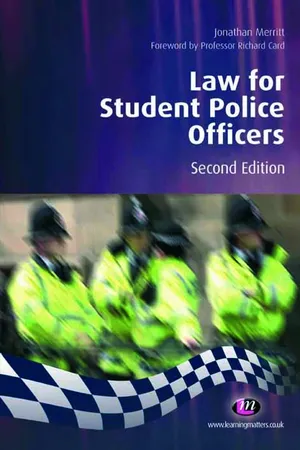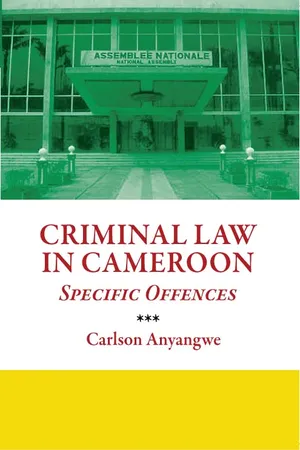Law
Grievious Bodily Harm (GBH)
Grievous Bodily Harm (GBH) refers to a serious physical injury inflicted intentionally or recklessly upon another person. It is a criminal offense and can result in severe legal consequences. GBH can include injuries such as broken bones, internal organ damage, or disfigurement, and the severity of the harm is a key factor in determining the level of criminal liability.
Written by Perlego with AI-assistance
Related key terms
1 of 5
7 Key excerpts on "Grievious Bodily Harm (GBH)"
- eBook - ePub
- Jonathan Merritt(Author)
- 2009(Publication Date)
- Learning Matters(Publisher)
R v Miller (1954) . In this case the term was felt to encompass any ‘hurt or injury likely to interfere with the health or comfort of the victim’. Thus significant bruising, a burn, cut (short of wounding – see next section), concussion or say a broken and displaced nose would all come within this definition. As we have seen, this is also true of mild psychiatric disorders such as panic attacks or depression.The harm must be more than ‘transient or trifling’ as was said in R v Donovan (1934) . This was supported by the ruling in R v Chan Fook (1994) .When dealing with an assault, even of a relatively minor nature as discussed here, your points of reference are case law, statute, CPS policy or guidelines and local force policy. When you write up such an incident in your SOLAP or reflective diary be sure to make links with each of these to ensure your entry receives maximum credit.Grievous bodily harm
The definition of this offence is found in s. 20 Offences Against the Person Act 1861 . The wording is:unlawfully and maliciously wound or inflict any grievous bodily harm upon any other person, either with or without any weapon or instrument.This is not the most transparent of legislative provisions and is not the same as the more serious grievous bodily harm with intent discussed in the next section. In fact, defying logic, it bears only the same maximum sentence as that for ABH, being five years in prison. This definition may be broken down as follows:- unlawfully;
- maliciously;
- wound or inflict grievous bodily harm (GBH).
Unlawfully
We have discussed at length what might render an assault lawful. Such issues as self-defence and consent could do so. The force used in self-defence would have to be reasonable and proportionate to the threat posed by the assailant.ACTIVITY
The Tony Martin case (a Norfolk farmer who shot and killed a burglar, wounding another) provoked great controversy over what could and could not be lawfully done to another in the defence of oneself, other people and one’s property. Politicians have proposed greater or lesser degrees of force as ‘reasonable’. The CPS moved to produce guidance on this issue in January 2005. You can see the updated version of this guidance at: - eBook - ePub
- Tony Storey, Alan Lidbury(Authors)
- 2012(Publication Date)
- Willan(Publisher)
Ireland).- Wounding means that the continuity of the skin must be broken (Moriarty v Brookes). Purely internal bleeding is not a ‘wound’ (JCC [a minor] v Eisenhower).
- GBH means really serious harm (DPP v Smith [1961]) or just serious harm (Saunders). It includes psychiatric injury (Burstow) but psychological harm does not suffice (Dhaliwal). The transmission of a serious disease through sexual intercourse can lead to liability for inflicting ‘biological’ GBH (Dica; Konzani).
- There is no practical distinction between ‘inflicting’ GBH and ‘causing’ GBH (Burstow).
- The word ‘maliciously’ in s.20 and s.18 means intentionally or recklessly.
- The subjective Cunningham test for recklessness applies to all non-fatal offences (Savage; DPP v Parmenter), including those that do not expressly require ‘malice’ (Venna).
- In s.47 it is sufficient mens rea that D foresees that their acts might result in force being applied to V, or that V is made apprehensive of force being applied to them. D does not have to have foreseen the degree of harm required for the actus reus, i.e. ABH (Roberts; Savage).
- In s.20 it is sufficient mens rea that D foresees that their acts might cause ‘some harm to some other person’. D does not need to have foreseen the degree of harm required for the actus reus, i.e. wounding or GBH (Mowatt; Savage).
- The draft Offences Against the Person Bill (1998) would abolish all of the above offences and replace them with four new offences: assault, intentional or reckless injury, reckless serious injury and intentional serious injury. ‘Injury’ would include physical or mental injury.
Passage contains an image
9 Consent
DOI: 10.4324/9780203722992-12Introduction
One thing that should become apparent upon reading this chapter is that the availability of the defence of consent has attracted a good deal of public debate in recent years. This is because consent often involves balancing the freedom of the individual against considerations of public policy as interpreted by the courts. - eBook - ePub
- Mary Charman, Bobby Vanstone, Liz Sherratt(Authors)
- 2012(Publication Date)
- Willan(Publisher)
In fact, although the legal boundaries of wounds leading to grievous bodily harm are unclear, there are guidelines for the police in the 1994 charging standards. The level of wounding expected to lead to a charge of grievous bodily harm includes:- injury resulting in permanent disability;
- permanent loss of any sensory function;
- significant permanent visible disfigurement;
- broken or displaced limbs or bones (including fractured skull, compound fractures, broken cheek bone, jaw, ribs etc.);
- injuries causing substantial loss of blood, usually requiring a transfusion; and
- injuries (physical or psychiatric) resulting in lengthy treatment or incapacity.
C (a minor) v Eisenhower (1984)A child who was shot by an air gun, the pellet rupturing a blood vessel in the eye and causing internal bleeding. Since the victim suffered internal injuries but no breaking of the skin, this did not amount to an offence under this statutory provision.Section 18 uses the word ‘cause’ and Section 20 uses the work ‘inflict’. Until recently the word ‘cause’ was thought to be wider (and therefore easier to prove) than ‘inflict’. However, in 1997 the House of Lords decided unanimously that there was no difference between the two words.R v Burstow (1997)The defendant was charged with inflicting grievous bodily harm when he caused his victim psychiatric harm by stalking her. He sent her hate mail, made malicious telephone calls, stole garments from her washing line and passed around intimate personal details about her family. The question arose as to whether Burstow had ‘inflicted’ the harm. It was held that there was no need to prove a direct use of force. Lord Hope said, ‘For all practical purposes … the words ‘cause’ and ‘inflict’ may be taken to be interchangeable.’Section 20
The mens rea for the offence generally known as malicious wounding under Section 20 is based on the word ‘maliciously’. Malice in this context does not necessarily mean the same as the old idea of evil or wicked, but it was said in Cunningham that in this context ‘maliciously’ meant intentionally or recklessly (remember the Cunningham - eBook - ePub
- Michael Mandelstam(Author)
- 2008(Publication Date)
- Jessica Kingsley Publishers(Publisher)
There does, however, have to be evidence of intention or recklessness for the offence to be committed. Thus, when three carers were accused of assault, by pouring talcum power into the mouth of an 87-year-old care home resident, they were acquitted. Whilst the district judge noted that the care had been below standard, and two of the carers admitted using unnecessary force when washing and handling the woman, nonetheless he could not be sure beyond reasonable doubt of intention or recklessness (Dayani 2004).8.1.1.1 Other offences going beyond common assaultThere are more serious offences. Assault occasioning bodily harm under s.47 of the Offences Against the Person Act 1861 carries a maximum of five years’ imprisonment. This offence is distinguished from common assault by the degree of injury resulting. For instance, common assault might typically concern grazes, scratches, abrasions, minor bruising, swellings, reddening of the skin, superficial cuts, or a black eye. Whereas actual bodily arm could include loss or breaking of a tooth or teeth, temporary loss of sensory functions including consciousness, extensive or multiple bruising, displaced or broken nose, minor fractures, minor but not superficial cuts, psychiatric injury beyond fear, distress or panic.Unlawful wounding or infliction of grievous bodily harm comes under s.20 of the Offences Against the Person Act 1861, carrying a maximum of five years’ imprisonment. Wounding would cover more serious cuts or lacerations, as opposed to more minor ones. Grievous bodily harm is serious bodily harm including, for example, injury resulting in permanent disability or permanent loss of sensory function, more than minor, permanent, visible disfigurement, broken bones, compound fractures, substantial loss of blood, injuries resulting in lengthy treatment or incapacity, psychiatric injury.Section 18 of the Act contains a similar offence but there must also be intent to cause wounding or grievous bodily harm (CPS/1).8.2 FALSE IMPRISONMENTFalse imprisonment is a common law offence involving the unlawful and intentional or reckless detention of a person:False imprisonment and death in a shed of vulnerable adult at the hands of those who has befriended him. A vulnerable and epileptic man died, after being kept in a shed for a period of four months by three people who had befriended him. He was found dead with extensive bruising and burn marks. The prosecution could not prove that death was not due to his epilepsy; the three defendants were jailed for some ten years each for assault, causing actual bodily harm and false imprisonment (de Bruxelles 2007a). However, a subsequent coroner’s hearing concluded that he had been unlawfully killed, almost certainly due to a loss of blood (Metro Newspaper - eBook - PDF
Criminal Law in Cameroon
Specific Offences
- Carlson Anyangwe(Author)
- 2011(Publication Date)
- Langaa RPCIG(Publisher)
A man who maimed another thereby rendered him less able to fight for the king and country as well as the man who maimed himself or consented to his own maiming to avoid enlistment were both guilty as perpetrators inasmuch as both contributed to the diminution of the king’s fighting force. Where mayhem, or the maiming of a person, was committed, the judgment was membrum pro membro (member for member; a reminder of the lex tallionis of antiquity or the ‘tooth for tooth’ principle in Mosaic law). But this judgment afterwards went out of use, partly because the law of retaliation is at best an inadequate rule of punishment. 623 Definition of ‘grievous harm’. A person commits grievous harm within the meaning of s.277 where he “permanently deprives another of the use of the whole or of any part of any member, organ or sense.” It is thus an offence to disfigure or to disable a person. There need be no danger to life or health or even serious interference with comfort, though this would usually be the case. What matters is the type and degree of the resulting harm. ‘Grievous’ means ‘serious’, ‘more than trifling’. 623 Russell on Crime , pp. 626-629. 318 The law presumes any disfigurement or disablement to be serious whether or not it presents any danger to life or health or interferes with comfort. Suppose that A slits the lobe of B ’s ear (or bites it off à la Mike Tyson) or chops off B ’s little finger or knocks off B ’s tooth, B would have been permanently deprived of a part of a member. But none of these injuries would present any danger to B ’s life or even interfere with his general health and such pain as he will feel would be only transitory. In The People v. Che Martin (1976) 624 the victim, Esther Ngu, tried to act the Good Samaritan but she was attacked and permanently deprived of a tooth. She was returning from Bambili market when she saw a boy being assaulted by two assailants. The defendant was one of them. She ran to the scene and tried to rescue the boy. - eBook - ePub
- Rodger Geary(Author)
- 2012(Publication Date)
- Routledge-Cavendish(Publisher)
Section 20 of the Offences Against the Person Act 1861 creates two offences of ‘... malicious wounding’ and ‘... maliciously inflicting grievous bodily harm’.Actus ReusA wounding requires a complete break of all the layers of the victim’s skin (JCC v Eisenhower (1984)). According to the House of Lords, grievous bodily harm means ‘really serious harm’ (DPP v Smith (1961)), although the Court of Appeal has indicated that it is sufficient for a trial judge to direct a jury that grievous bodily harm simply means ‘serious harm’ (R v Saunders (1985)). On a charge of murder, when directing the jury as to the degree of bodily harm intended, it is for the judge to decide in each case whether it is necessary to use the word ‘really’ before the words ‘serious bodily harm’ (R v Janjua; R v Choudhury (1998)).Although most offences under s 20 will involve an assault, it was decided in R v Wilson (1983) that ‘inflicting’ does not necessarily imply an assault. It has therefore been suggested that if ‘inflicting’ was to have any meaning at all, it had to imply the need for causation. However, in Burstow and Ireland (1997), the House of Lords confirmed that ‘inflicting’ did not imply an assault or the violent application of force to the body, but held that ‘cause’ and ‘inflict’ are not synonymous although there is no ‘radical divergence’ of meaning. Lord Hope stated that ‘... the word “inflict” implies that the consequence of the act is something which the victim is likely to find unpleasant or harmful’. Surely, this approach must be misconceived. After all, what about Brown and Others - eBook - PDF
Lacey, Wells and Quick Reconstructing Criminal Law
Text and Materials
- Celia Wells, Oliver Quick(Authors)
- 2010(Publication Date)
- Cambridge University Press(Publisher)
This could have special relevance in 244 Lacey, Wells and Quick Reconstructing Criminal Law Text and Materials public order cases. Imagine a chaotic situation in which a demonstration has become disorderly and the police respond vigorously. It is not impossible to imagine a court inferring intention to resist arrest where a defendant has caused a wound or grievous bodily harm, even though the injury itself was negligent or even accidental in the heat of the moment. The possible disjuncture between defendants’ own understandings of their actions and courts’ interpretation in applying the law is very clear even in the case of an offence with a stringent ‘mens rea’ requirement. III.8.b. Boundary issues III.8.b.i. Psychiatric harm Does stalking, when it takes the form of harassment through silent telephone calls and other non-verbal behaviour, come within the definition of assault, or assault occasioning actual bodily harm? Two hurdles had to be surmounted to bring such cases within the rather archaic language and conception of violence in the common law and statutory framework of offences against the person. The first was whether such conduct amounts to an assault, that is, does it cause an apprehension of immediate violence? In Burstow and Ireland, the House of Lords cut through the technical interpretation of ‘assault’ and ‘inflict’ (the use of this latter word in s. 20 had been thought to imply a technical assault had to accompany the injury) to achieve a more modern understanding of the range of harms covered by these offences. A second question arose in these appeals: whether ‘harm’ in sections 47, 20 and 18, covers both psychiatric as well as physical injury.
Index pages curate the most relevant extracts from our library of academic textbooks. They’ve been created using an in-house natural language model (NLM), each adding context and meaning to key research topics.






